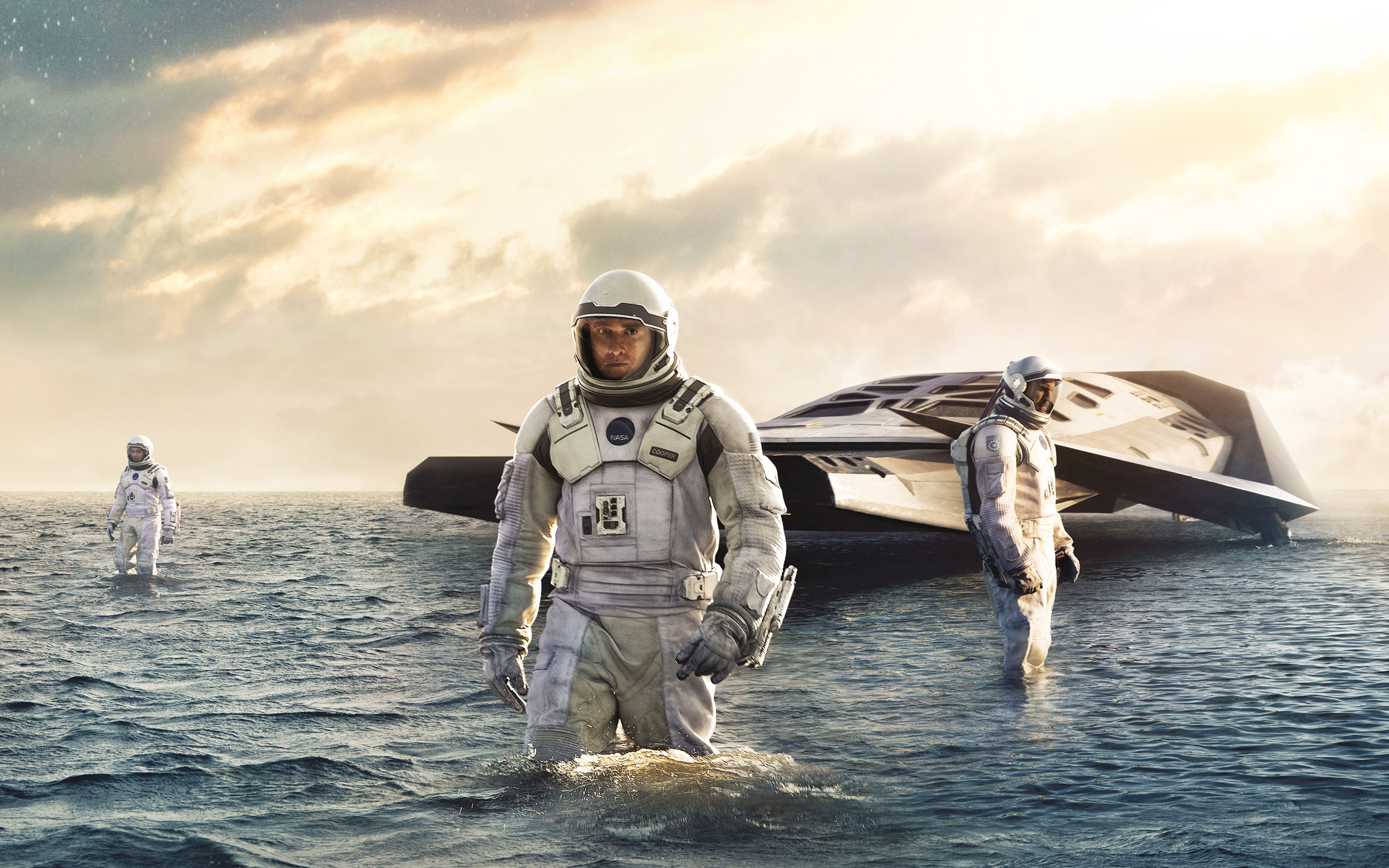Interstellar (2014) is not just a science fiction film; it’s a breathtaking exploration of space, time, and human emotion. It presents an ambitious narrative that blends cutting-edge science with heartfelt storytelling, all while challenging viewers to think about the future of humanity. From the emotional depth of the characters to the stunning visual effects, there’s so much to unpack in this cinematic masterpiece. Let’s take a deeper dive into the intricate details that make Interstellar one of the most fascinating films of the 21st century. This film was also ranked as our favorite in Nolan’s Filmography, just beating out The Prestige and The Dark Knight.

A Story Rooted in Science
At its core, Interstellar is a story of survival. In a future where Earth is on the brink of collapse due to crop failures and dust storms, a team of astronauts ventures into space to search for a new home for humanity. While the premise may sound like a typical sci-fi tale, what sets Interstellar apart is the extraordinary attention to scientific detail, particularly in the realms of astrophysics and relativity.
The film’s scientific advisor, Kip Thorne, a Nobel-winning physicist, ensured that the depiction of black holes, wormholes, and time dilation were grounded in real scientific theories. The iconic visual representation of Gargantua, the black hole, was meticulously designed using complex equations, resulting in some of the most realistic and mind-bending imagery ever captured on film. The depiction of time dilation — where time slows down near a massive gravitational field — is a key plot element and is explained with remarkable precision.
The film’s exploration of wormholes is another nod to real science. While we don’t yet have the technology to create or enter wormholes, the film’s depiction of these cosmic shortcuts is based on the theories of physicist Carl Sagan and others. The wormhole, conveniently placed near Saturn, becomes the gateway to humanity’s future, leading our heroes to distant planets where they hope to find a new home.
Visual Mastery and Cinematic Realism
When it comes to visuals, Interstellar is a spectacle. From the vast expanse of space to the desolate, dust-covered Earth, the film’s cinematography is breathtaking. Shot on 70mm IMAX film, Interstellar utilizes practical effects, models, and CGI to bring its cosmic elements to life with a level of realism that few films can match.
One of the film’s most stunning sequences involves a close-up view of Gargantua, the massive black hole. The way the black hole bends light and distorts time was crafted using Thorne’s equations, resulting in a visual representation that has since been hailed as scientifically accurate. The sheer scale of the black hole and the surrounding accretion disk—filled with swirling, glowing light—immerses viewers into the film’s hauntingly beautiful depiction of the universe.
Even the alien planet landscapes are meticulously designed. From the water world with its massive tidal waves to the icy mountains of Mann’s planet, each environment feels meticulously detailed, crafted to not only awe but also convey the immense danger these astronauts face. The desolate yet spectacularly beautiful landscapes serve as the perfect backdrop for the existential themes of the film.

The Soundtrack: A Symphony of Emotions
Hans Zimmer’s score for Interstellar is one of the most evocative soundtracks in cinematic history. Zimmer’s music captures the vastness of space while also conveying the intimacy of the human struggle for survival. The haunting organ music, which resonates throughout the film, serves as both a spiritual and emotional anchor. The ticking clock-like motif underscores the theme of time, an ever-present force in the narrative.
The soundtrack is a perfect match for the film’s tone. It elevates the emotional stakes, especially in pivotal moments. The use of silence, juxtaposed with powerful crescendos, mirrors the tension between life and death, hope and despair. One of the most powerful uses of the score is during the emotional sequence between Cooper (Matthew McConaughey) and his daughter Murph (Jessica Chastain), as he communicates across time and space.

The Human Element: Family, Sacrifice, and Love
At its heart, Interstellar is a story about love, sacrifice, and the bond between a father and his daughter. While the film explores cosmic themes of survival and the future of humanity, it never loses sight of the emotional journey of its characters. Cooper’s drive to save his daughter, Murph, is the emotional core of the film, giving the story a grounding force amid the vastness of space.
The film explores how love transcends time and space, a concept that might sound abstract but is made tangible through the relationships depicted on-screen. Cooper’s love for Murph, which endures across different dimensions of time, is the central metaphor of the film. His decision to leave Earth, knowing he may never see her again, is a heart-wrenching moment. This sacrifice resonates deeply, as Cooper’s choice to embark on the mission is driven by hope for the future of humanity but rooted in his love for his daughter.
The theme of sacrifice is also explored through other characters, particularly Dr. Brand (Anne Hathaway), whose relationship with the mysterious Dr. Edmunds (Topher Grace) adds an emotional dimension to her otherwise logical and scientific persona. Brand’s decision to continue with the mission, even when faced with the possibility of personal loss, highlights the tension between duty and personal desire.
The Ending: A Journey Beyond Time
The ending of Interstellar is where it all comes full circle. Cooper’s journey into the black hole and his eventual encounter with the tesseract, a four-dimensional space, is both visually and thematically profound. The tesseract scene — where Cooper interacts with time itself, reaching out to his younger self and Murph — is one of the most mind-bending sequences in film history. It is a representation of time as a physical dimension, as well as a metaphor for the film’s central theme: the interconnectedness of all things.
The conclusion of the film is bittersweet but ultimately hopeful. Humanity’s survival is secured, and Cooper, having fulfilled his mission, is reunited with Murph, who has now grown old. The film closes with a quiet reflection on the enduring power of human connections, love, and the will to explore the unknown.

Final Thoughts
Interstellar is a film that rewards careful and repeated viewing. Its layers of meaning, from the scientific to the emotional, combine to create an experience that resonates long after the credits roll. Whether it’s the realistic depiction of space and time, the mesmerizing visuals, or the emotional depth of the characters, Interstellar offers something for everyone. Nolan’s meticulous attention to detail, paired with Zimmer’s evocative score, creates a cinematic journey that is as intellectually stimulating as it is emotionally profound.
In a genre often focused on spectacle and action, Interstellar stands as a testament to the power of storytelling. It asks big questions, provides no easy answers, and invites viewers to reflect on the future of our species, the mysteries of the universe, and the connections that bind us all.
If there is anything we missed make sure to leave a comment. Also make sure to check out our blog on Every Christopher Nolan Film Ranked
Pingback: Top 10 Saddest Movies That Will Make You Cry - Collector's Caves
Pingback: The Best 4K Movies for a Cinematic Experience Like No Other - Collector's Caves
Pingback: The 10 Best Sci-Fi Movies of All Time - Collector's Caves
Pingback: The Dark Knight Movie Review - Collector's Caves
Pingback: The Prestige Film Review - Collector's Caves
Pingback: Christopher Nolan's Filmography Ranked - Collector's Caves
https://shorturl.fm/A5ni8
https://shorturl.fm/N6nl1
https://shorturl.fm/9fnIC
https://shorturl.fm/a0B2m
https://shorturl.fm/6539m
https://shorturl.fm/FIJkD
https://shorturl.fm/a0B2m
https://shorturl.fm/XIZGD
https://shorturl.fm/6539m
https://shorturl.fm/9fnIC
https://shorturl.fm/6539m
https://shorturl.fm/68Y8V
https://shorturl.fm/a0B2m
https://shorturl.fm/N6nl1
https://shorturl.fm/A5ni8
https://shorturl.fm/oYjg5
https://shorturl.fm/nqe5E
https://shorturl.fm/ypgnt
https://shorturl.fm/IPXDm
https://shorturl.fm/I3T8M
https://shorturl.fm/IPXDm
https://shorturl.fm/hevfE
https://shorturl.fm/retLL